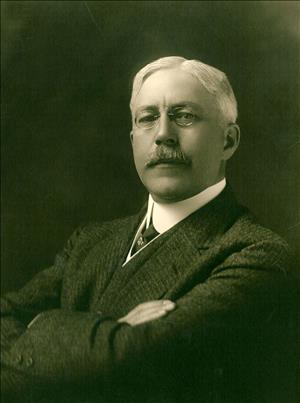On October 2, 1894, Stephen B. L. Penrose (1864-1947) arrives in Walla Walla, Washington, and begins a 40-year tenure as the third president of Whitman College. Penrose had first come to Washington state straight out of Yale Divinity School, under the auspices of the Congregational American Home Mission Society. After revitalizing a Congregational church in Dayton, Penrose was called to the presidency of Whitman College. As a trustee, Penrose was aware of the college's financial problems; but he decided to accept the challenge and he dedicated his life to building up the school. Although the college will be in a precarious position again when he retires in 1934, others will build successfully upon the firm foundation that he will lay.
An Easterner Goes West
Stephen Beasley Linnard Penrose was born into prominent Philadelphia family and educated at Williams College, Princeton Theological Seminary, and Yale Divinity School. He was ordained as a Congregational minister and, with five of his Yale classmates, signed on with the American Home Missionary Society to go to the new Washington state. In 1890, Penrose arrived in Dayton and began working to revitalize the town’s 13-year-old Congregational church.
Penrose became involved in the Washington State Congregational Association and, in 1892, was elected to the Whitman College board of trustees. He also became the board’s secretary and a member of its executive committee. In the summer of 1894, Penrose traveled to Honolulu and then to San Francisco, where he received a telegram informing him that he had been selected to be president of Whitman College. Penrose was aware that the school faced significant challenges in the current economic environment, but he was encouraged by the optimism of faculty, students, and other friends of the college. In October, Penrose agreed to become the college’s third president.
An Easterner in the West
Penrose began his presidency with a massive fundraising effort. With funds and advice from Chicago philanthropist D. K. Pearsons, he secured a sizable amount of money for the college’s endowment and first masonry buildings, including the Whitman Memorial Building (completed in 1900). Penrose was inspired by -- and inspired numerous college supporters with -- the legendary life of Marcus Whitman. Building up Whitman as a national hero, Penrose hoped to create a national reputation for Whitman College. Assisting him with his institution-building endeavors was his wife, Mary (Shipman) Penrose, from Hartford, Connecticut, whom he married in 1897.
The first 13 successful years of Penrose’s presidency were followed by a much less glorious period. In 1907, after ending its formal relationship with the Congregational Church, a plan called “Greater Whitman” was launched that sought to transform Whitman into a regional center for advanced technical training. This ambitious plan failed to attract sufficient funding and it was abandoned by 1912. After a more modest but successful fundraising campaign to cover the school’s debt, and a return to the ideal of a small liberal arts college, in the early 1920s Whitman settled into a period of relative prosperity.
But in 1934, in one of the worst years of the Great Depression, a blind and beleaguered Penrose resigned from the presidency. Penrose continued to teach at Whitman, and remained a prominent presence on campus. In a notice of his death in The New York Times in 1947, Penrose’s labors and devotion for Whitman College were said to have “few parallels in the field of American education” (quoted in Stickles, Another Sort of Pioneer, 277).

